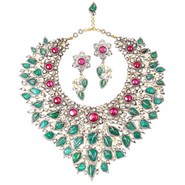- About
- Subscribe Now
- New York,
May 16, 2014

 Amrapali's Sadabhar suite for Project Blossoming
Amrapali's Sadabhar suite for Project Blossoming
Colored-gemstone miner Gemfields is extending its sustainable business practices into civic engagement with a charity partnership, Project Blossoming, with India’s Project Nanhi Kali.
Translated to mean “little bud” in Hindi, Project Nanhi Kali is dedicated to improving the lives of Indian girls through education. Selecting a charity rooted in India is fitting for Gemfields, since the country is a key market for the brand.
"Giving back is at the core of what Gemfields does – whether it is to the local environments and communities where we mine, or to the places and people who purchase our gemstones," said Randi Molofsky, marketing director for Gemfields, New York. "India is one of our strongest international markets, and we are always looking for ways to support this country that has such a deep affinity for colored-gemstones.
"Our hope is that with the money raised, we'll be able to fund the education of a minimum of 2,000 girls for two years," she said. "That includes tuition, uniforms, books and more.
"Gemfields will be tracking the progress of these girls, and hopefully we'll be able to see them grow and flourish for years to come."
Blossoming with potential
The philanthropic endeavors between Gemfields and Project Nanhi Kali form the Project Blossoming partnership. The charity hopes to lend support to young Indian girls who may “blossom” with potential through education.
For Project Blossoming, the partners have teamed up with 10 of India’s leading jewelers. Each jeweler has created a piece of jewelry inspired by the notion of blossoming.
Tibarumals Jewelers' interpretation of blossoming
According to the project’s Web site, the pieces will “embody a promise -- that there is hope for the future of these young girls.”
Since 1996, Project Nanhi Kali has helped more than 90,000 Indian girls.
On June 6, after the collection does a tour of the participating jewelers' boutiques throughout India, Christie’s will hold an auction sale in Mumbai for the pieces. Project Blossoming’s goal is to use the proceeds to support the educational aspirations of 2,000 girls.
The Project Blossoming collection features pieces from Abaran in Bangalore, Amrapali of Jaipur, Anmol Jewelers in Mumbai, Hazoorilal in New Delhi, Lala Jugal Kishore Jewelers of Lucknow, Mirari in New Delhi, Moksh of Mumbai, Narayan Jewelers of Baroda, Talwarsons in Chandigarh and Tibarumals Jewelers of Hyderabad.
Full collection for Project Blossoming
All of the pieces in the Project Blossoming collection focus on Gemfields-mined emeralds from Zambia, rubies from Mozambique and diamonds. Depending on the suite, prices from the collection range from $40,000 to $160,000.
Although the collection pieces will be of a high value, it is inexpensive to fund Indian education. For instance, $40 can fund a year of primary schooling and $60 allows for a year of secondary school.
To increase exposure for the charity, Project Blossoming has selected Bollywood actress Chitrangda Singh as celebrity ambassador. Ms. Singh is featured in an interview video on the Project Blossoming Web site to explain the importance of the initiative.
An interview with Chitrangda Singh explaining Project Blossoming
Harper’s Bazaar India is also working to promote the Project Blossoming cause by including all the pieces in a bridal jewelry spread with 1970s hair-dos. The magazine is sharing the photo spread via social media.
Amrapali's Sadabhar as seen in Harper's Bazaar India
Wearable ethics
High-jeweler brands have pledged to provide consumers with ethically-sourced raw materials.
For example, Switzerland’s Chopard took its consumers on an ethical journey down the green carpet to emphasizes its sustainable practices.
The jeweler released its inaugural Green Carpet Collection in support of ethically-sourced materials in 2013 at the Cannes Film Festival. Since then, Chopard has worked to further expand its sustainability efforts through additional jewelry pieces and an active digital presence that spreads awareness (see story).
Brands with a dedication to sustainability extend beyond jewelers.
Luxury conglomerate Kering spoke at the third Copenhagen Fashion Summit on sustainability to highlight its work.
Since the first Copenhagen Fashion Summit in 2009, Kering has been a keynote speaker at the biennial event. Kering is able to position itself as a leader in sustainability practices among luxury brands and companies through this participation (see story).
A well-curated initiative that connects the brand to local social issues is more likely to leave an impression on that segment of consumers.
“Gemfields is certainly highlighting India as a prominent provider of colored gemstones through Project Blossoming,” said Andrew Kelly, director of market development at Baesman, Columbus, OH.
“However, I think the impact will have more of an effect on girls' education in India rather than where Gemfields is sourcing their jewels, although as a transparent gemstone provider they are without a doubt building publicity,” he said. “I’m not sure if it enhances the cause so much as it juxtaposes the glaring chasm between First World privileges and Third World realities through the act of spending an enormous sum of money on an object to benefit children halfway around the world in very unfortunate circumstances.”
“When a charity or a cause is very focused and specific, it creates a more powerful emotional connection and a more powerful story that translates into a bigger impact because it’s easier to understand, provides a context and makes it easier to relate to."
Final Take
Jen King, editorial assistant on Luxury Daily, New York
Share your thoughts. Click here